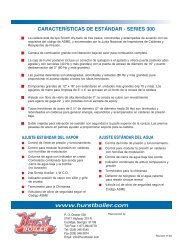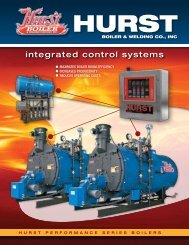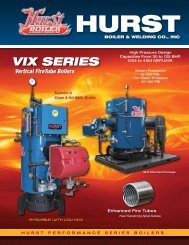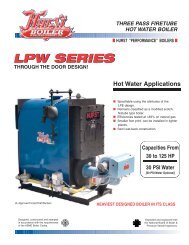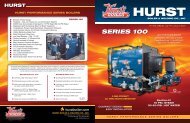Component & System Guide - Hurst Boiler
Component & System Guide - Hurst Boiler
Component & System Guide - Hurst Boiler
Create successful ePaper yourself
Turn your PDF publications into a flip-book with our unique Google optimized e-Paper software.
H U R S T B O I L E R S E R I E S “ M H ”<br />
removed at the secondary collector. The drop out is similarly expelled through a rotary<br />
air lock, though re-injection is not an option at this point. Pressure drops similar to the<br />
primary collector can be anticipated with dramatic changes indicating a blockage.<br />
<strong>Hurst</strong> <strong>Boiler</strong> Co. also has experience in designing its systems to incorporate the latest<br />
pollution technologies (scrubbers, core separators, bag houses, absorbers, SNCR, flue<br />
gas recirculation, urea injection, electrostatic precipitators (dry or wet)) that may be<br />
required to meet more stringent environmental regulations at different locations<br />
around the world.<br />
Secondary pollution controls may be required depending on the types of fuels utilized,<br />
BTU input of the system and state or federal regulation, including the new <strong>Boiler</strong><br />
MACT rules that are expected to come into effect soon. <strong>Hurst</strong> is prepared to<br />
accommodate and integrate all types of secondary controls into our systems.<br />
Typically, there a three types of secondary particulate control systems available with<br />
extensive, successful application to solid fueled boiler systems. The first is the wet<br />
scrubber. The wet scrubber is fairly cheap to operate and has low capital costs. Wet<br />
scrubbers have a higher pressure drop (requires a larger induced draft fan) and require a<br />
waste water stream to reduce operational costs. The second is the electro static<br />
precipitator which uses charged plates to trap particulate very efficiently. These systems<br />
typically have the highest capital costs, lower pressure drops and do require additional<br />
electricity to operate their transformer(s). The last choice is a bag house. There are<br />
many different types of bag houses and bags that can be used to remediate particulate<br />
as well as some other regulated gases. Bag houses do have a large pressure drop across<br />
them and are efficient. However, industrial experience shows us that these systems will,<br />
eventually, suffer from internal fires. Sometimes the bags will burn and require<br />
replacement but most often the “cake” on the bags may catch fire and produce enough<br />
heat to cause structural damage. It is almost a certainty, thus making bag houses the last<br />
choice when evaluating remediation technologies.<br />
15



